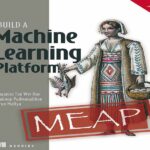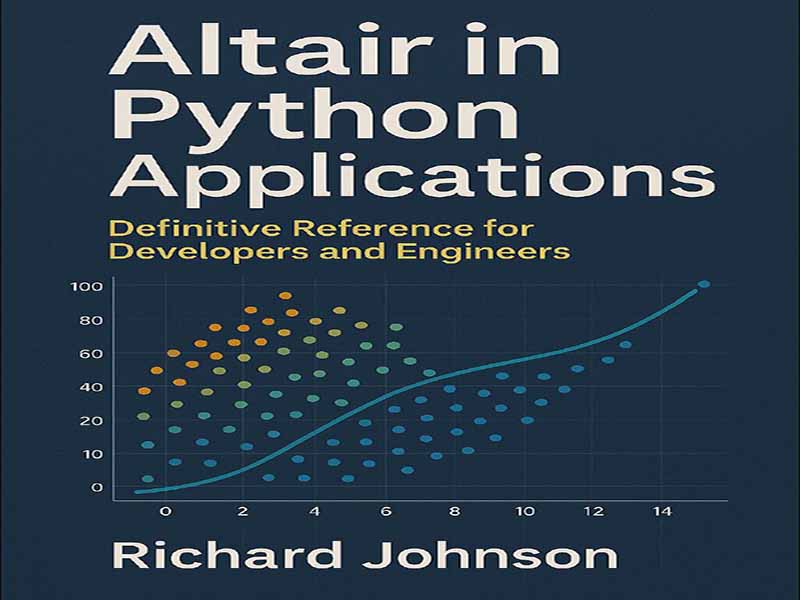- عنوان کتاب: Altair in Python ApplicationsDefinitive Reference for Developers and Engineers
- نویسنده: Richard Johnson
- حوزه: برنامه نویسی پایتون
- سال انتشار: 2025
- تعداد صفحه: 197
- زبان اصلی: انگلیسی
- نوع فایل: pdf
- حجم فایل: 1.32 مگابایت
Altair یک کتابخانه تجسم آماری مدرن و اعلانی برای پایتون است که برای سادهسازی ایجاد گرافیکهای معنادار و آموزنده از طریق یک سینتکس شهودی مبتنی بر دستور زبان گرافیک طراحی شده است. این کتاب، Altair در برنامههای پایتون، کاوشی جامع و دقیق از قابلیتهای Altair ارائه میدهد و خوانندگان را در مورد اصول بنیادی، ویژگیهای پیشرفته، کاربردهای عملی و ادغام آن در اکوسیستم وسیعتر پایتون راهنمایی میکند. فصلهای اولیه با معرفی مفاهیم اصلی تجسم اعلانی و تشریح رابطه نزدیک Altair با دستور زبان تجسم Vega-Lite، پایه و اساس را بنا مینهند. این مباحث درک روشنی از مدل داده Altair، استنتاج طرحواره و نحوه تعامل یکپارچه Altair با ساختارهای داده پرکاربرد مانند Pandas DataFrames ایجاد میکنند. خوانندگان به روششناسی لازم برای نصب، پیکربندی و حفظ یک محیط Altair پایدار متناسب با نیازهای توسعه خود مجهز خواهند شد. علاوه بر این، تشریح آناتومی نمودار – شامل علامتها، کانالهای کدگذاری و پارامترهای پیکربندی – چارچوبی دقیق برای نگاشت مؤثر ویژگیهای داده به نمایشهای بصری فراهم میکند. تجزیه و تحلیلهای مقایسهای با سایر کتابخانههای تجسم رایج، متخصصان را قادر میسازد تا تشخیص دهند که Altair چه زمانی مزایای متمایزی برای کارهای گرافیکی پیشرفته ارائه میدهد. این کتاب با فراتر رفتن از اصول اولیه، به بررسی تبدیلهای پیچیده دادهها و استراتژیهای کدگذاری میپردازد که پتانسیل کامل Altair را آزاد میکنند. خوانندگان با تکنیکهایی برای مدیریت انواع دادههای پیچیده، مقیاسهای چندبعدی و عملیاتهای پیچیده تبدیل مانند تجمیع، حذف و فیلدهای محاسبهشده آشنا میشوند. متن بر کدگذاریهای واکنشگرا و شرطی، تعاملات پویای کاربر و شیوههای تجسم دادههای زمانی که برای تجزیه و تحلیل جامع زمانی حیاتی هستند، تأکید دارد. علاوه بر این، روشهای ترکیبی مانند سطوحبندی، تکرار و الحاق طرحبندی به طور کامل بررسی میشوند تا ساخت الگوهای بصری ساختاریافته و مضربهای کوچک را تسهیل کنند. با تکیه بر این تکنیکها، روایت به سمت توسعه تجسمهای پیشرفته پیش میرود. ترکیب نمودارهای لایهای و مرکب برای تولید گرافیکهای غنی و توضیحی متناسب با نیازهای تحلیلی متنوع بررسی میشود. فصلهای اختصاص داده شده به علائم سفارشی و انواع نمودارهای تخصصی، خوانندگان را با پیادهسازی عناصر بصری جدید از جمله نمودارهای ویولن، نمودارهای رادار و اشکال جغرافیایی آشنا میکند. گفتمان در مورد سفارشیسازی زیباییشناختی، به مضامین، پالتهای رنگی، تایپوگرافی و ملاحظات برندسازی میپردازد تا اطمینان حاصل شود که تجسمها با دستورالعملهای سبک خاص مطابقت دارند. توصیههای کاربردی برای بهینهسازی عملکرد رندر، مدیریت مجموعه دادههای بزرگ و طراحی داشبوردهای تعاملی و چندنمایی، خوانندگان را برای پرداختن به چالشهای محیطهای داده دنیای واقعی مجهز میکند. تعامل همچنان یک موضوع حیاتی است و به طور متمرکز بر انتخابهای اعلانی، پارامترسازی و تجزیه و تحلیل کاربرمحور تمرکز دارد. این کتاب در مورد استراتژیهایی برای پیکربندی انواع انتخابهای چندگانه، اتصال ویژگیهای بصری به پارامترهای واکنشی و فعال کردن فیلتر متقابل بین نماهای هماهنگ بحث میکند. برای کاربران پیشرفته، ادغام جاوا اسکریپت سفارشی، تعامل Altair را گسترش میدهد و ادغام کنترلهای ورودی مانند اسلایدرها و منوهای کشویی به تفصیل شرح داده شده است. توجه ویژهای به اصول دسترسی و قابلیت استفاده شده است و تضمین میکند که تجسمهای تعاملی توسط مخاطبان مختلف قابل فهم و پیمایش هستند. این جلد با درک اهمیت ادغام، گردش کار Altair را در اکوسیستم پایتون بررسی میکند. این کتاب، جاسازی نمودارها در محیطهای محاسباتی تعاملی مانند نوتبوکهای Jupyter را برجسته میکند و گزینههای استقرار در چارچوبهای برنامههای وب از جمله Flask، Django و FastAPI را نشان میدهد. ادغام با خطوط لوله علوم داده، خروجی گرفتن در قالبهای مختلف و سازگاری با ابزارهای داشبورد front-end مانند Streamlit و Dash نیز پوشش داده شده است. بهترین شیوهها برای کنترل نسخه، همکاری و قابلیت تکرارپذیری، Altair را به عنوان ابزاری قوی برای گردشهای کاری حرفهای داده معرفی میکند. برای کاربرانی که به دنبال گسترش قابلیتهای Altair هستند، این کتاب مروری عمیق بر مکانیسمهای توسعه، backendهای رندر سفارشی، قالببندی پیشرفته و افزونههای مشارکتی ارائه میدهد. راهنمایی در مورد توسعه طرحواره، اشکالزدایی، آزمایش و پروفایل عملکرد، توسعهدهندگان را در ساخت راهحلهای تجسمی قابل اعتماد و با کارایی بالا پشتیبانی میکند. مطالعات موردی دنیای واقعی، کاربرد Altair را در حوزههای متنوعی مانند تحقیقات علمی، هوش تجاری، تفسیرپذیری مدل یادگیری ماشین، تجزیه و تحلیل مالی، تجسم مکانی و ارتباط با ذینفعان نشان میدهد. این مثالها، تطبیقپذیری و اثربخشی Altair را در انتقال بینشهای پیچیده به مخاطبان فنی و غیرفنی تأیید میکنند. متن با پرداختن به جنبههای عملیاتی حیاتی، استراتژیهای بهینهسازی عملکرد را برای مقیاس بزرگ بررسی میکند.
Altair is a modern, declarative statistical visualization library for Python, designed to simplify the creation of meaningful and insightful graphics through an intuitive syntax grounded in the grammar of graphics. This book, Altair in Python Applications, presents a comprehensive and detailed exploration of Altair’s capabilities, guiding readers through its fundamental principles, advanced features, practical applications, and integration within the broader Python ecosystem. The initial chapters lay the foundation by introducing the core concepts of declarative visualization and outlining Altair’s close relationship with the Vega-Lite visualization grammar. These discussions establish a clear understanding of the Altair data model, schema inference, and how Altair seamlessly interacts with widely used data structures such as pandas DataFrames. Readers will be equipped with the necessary methodology to install, configure, and maintain a stable Altair environment tailored to their development needs. Furthermore, the dissection of chart anatomy— including marks, encoding channels, and configuration parameters— provides a precise framework to effectively map data attributes into visual representations. Comparative analyses with other prevalent visualization libraries enable practitioners to discern when Altair offers distinct advantages for advanced graphical tasks. Moving beyond fundamentals, the book delves into sophisticated data transformations and encoding strategies that unlock Altair’s full potential. Readers are introduced to techniques for handling complex data types, multi-dimensional scales, and elaborate transformation operations such as aggregation, binning, and calculated fields. The text emphasizes responsive and conditional encodings, dynamic user interactions, and temporal data visualization practices vital for comprehensive temporal analytics. Additionally, compositional methods such as faceting, repetition, and layout concatenation are thoroughly examined to facilitate the construction of structured visual patterns and small multiples. Building upon these techniques, the narrative progresses to the development of advanced visualizations. The combination of layered and composite charts is explored to produce rich, explanatory graphics tailored to diverse analytical requirements. Chapters dedicated to custom marks and specialized chart types introduce readers to implementing novel visual elements including violin plots, radar charts, and geospatial shapes. The discourse on aesthetic customization addresses theming, color palettes, typography, and branding considerations to ensure visualizations meet specific style guidelines. Practical advice for optimizing rendering performance, handling large datasets, and designing interactive, multi-view dashboards equips readers to address the challenges of real-world data environments. Interactivity remains a critical theme, with focused treatment of declarative selections, parameterization, and user-driven analytics. The book discusses strategies to configure multiple selection types, bind visual attributes to reactive parameters, and enable cross-filtering between coordinated views. For advanced users, integration of custom JavaScript extends Altair’s interactivity, and the incorporation of input controls such as sliders and dropdowns is detailed. Special attention is given to accessibility and usability principles, ensuring that interactive visualizations are understandable and navigable by diverse audiences. Recognizing the importance of integration, this volume examines Altair’s workflow within the Python ecosystem. It highlights embedding charts within interactive computing environments such as Jupyter notebooks and demonstrates deployment options in web application frameworks including Flask, Django, and FastAPI. Integration with data science pipelines, exporting in multiple formats, and compatibility with front-end dashboard toolkits like Streamlit and Dash are also covered. Best practices for version control, collaboration, and reproducibility frame Altair as a robust tool for professional data workflows. For users seeking to extend Altair’s functionality, the book provides an indepth overview of extension mechanisms, custom rendering backends, advanced theming, and community-contributed plugins. Guidance on schema extension, debugging, testing, and performance profiling supports developers in building dependable, high-performance visualization solutions. Real-world case studies illustrate Altair’s application across diverse domains such as scientific research, business intelligence, machine learning model interpretability, financial analytics, geospatial visualization, and stakeholder communication. These examples affirm Altair’s versatility and effectiveness in conveying complex insights to both technical and nontechnical audiences. Addressing critical operational aspects, the text investigates performance optimization strategies for large-scale data, rendering trade-offs between client-side and server-side execution, efficient memory usage, secure sharing of visualizations, and management of confidential data. Robust monitoring and logging methodologies for Altair-powered production environments reinforce the practical utility of the approach. Finally, the book surveys emerging trends and future directions in declarative visualization, highlighting ongoing evolution of visualization grammars, interoperability standards, cloud-native analytics platforms, and integration with artificial intelligence. It underscores the vitality of community engagement, open-source contributions, and the vision toward universal visualization grammars to drive innovation and broad adoption. This book serves as an authoritative reference and practical guide for data scientists, analysts, researchers, and developers who seek to master Altair for effective data visualization and interactive analytic applications. It balances conceptual rigor, technical depth, and real-world relevance to foster a comprehensive understanding of Altair as a powerful instrument in the modern data visualization landscape.
این کتاب را میتوانید از لینک زیر بصورت رایگان دانلود کنید:
Download: Altair in Python ApplicationsDefinitive Reference for Developers and Engineers




































نظرات کاربران